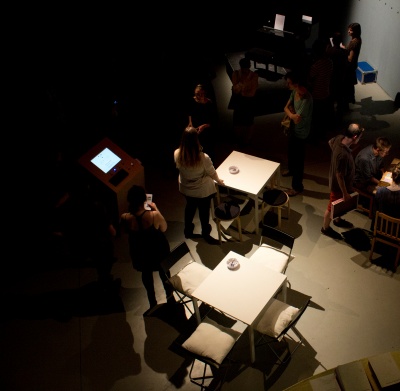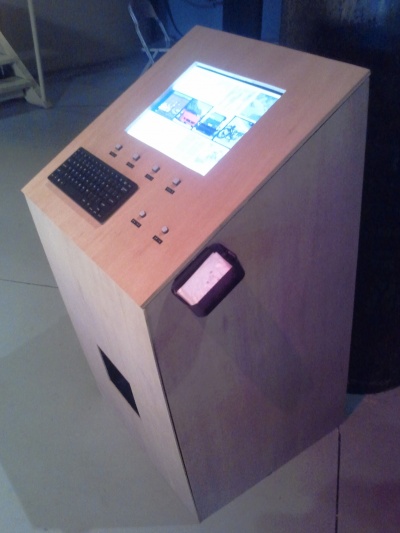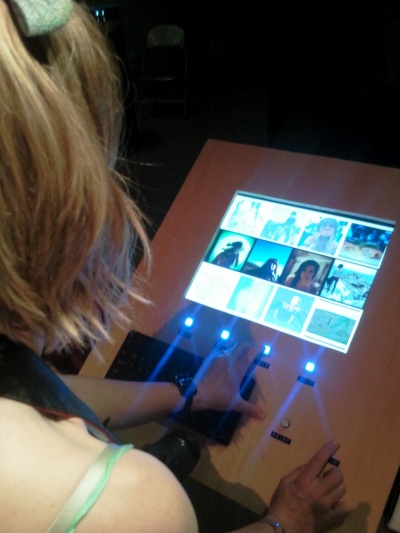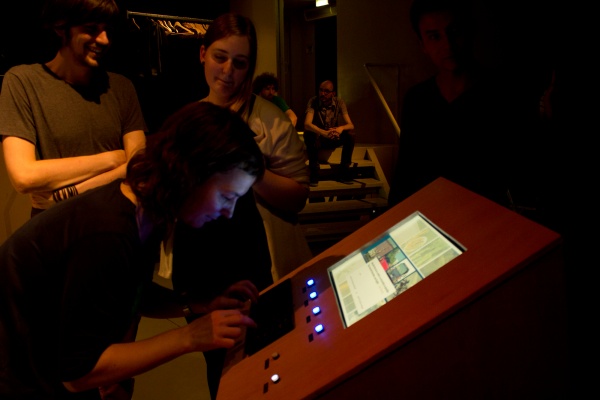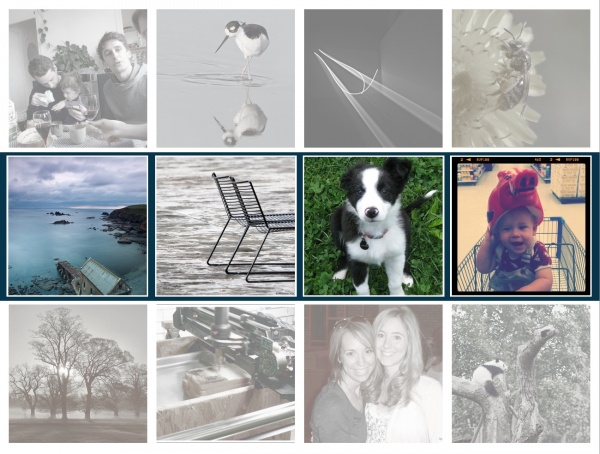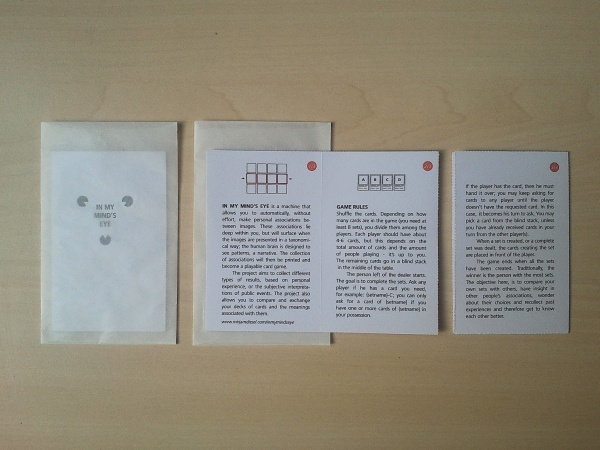User:Mirjam Dissel/Mirjam Dissel, In My Mind's Eye, 2012: Difference between revisions
No edit summary |
(→Video) |
||
| Line 47: | Line 47: | ||
[[File:Cards 3596.jpg|600px|thumb|center|A group of people playing quartet with a mixed deck, trying to figure out what the selected images have to do with the chosen title, and what the title is about in the first place; thus getting to know a bit about each other's history and about their mind flow.]] | [[File:Cards 3596.jpg|600px|thumb|center|A group of people playing quartet with a mixed deck, trying to figure out what the selected images have to do with the chosen title, and what the title is about in the first place; thus getting to know a bit about each other's history and about their mind flow.]] | ||
<br><br> | <br><br> | ||
== Thesis == | == Thesis == | ||
Revision as of 20:28, 5 July 2012
In My Mind's Eye
Description - 75 words
In My Mind's Eye is a machine that allows the user to automatically, without effort, make personal associations between images. The collection of associations will then be printed and become a playable card game. The project aims to collect different types of results, based on personal experience, or the subjective interpretations of public events. The project also allows the users to compare and exchange their decks of cards and the meanings associated with them.
Description - 115 words
In My Mind's Eye is a machine that allows the user to automatically, without effort, make personal associations between images. These association lie deep within them, but will surface when the images are presented in a taxonomical way; the human brain is designed to see patterns, a narrative. The user is asked to create a meaningful set of images and name it; the set will then be printed and become a playable card game. The project aims to collect different types of results, based on personal experience, or the subjective interpretations of public events. The project also allows the users to compare and exchange their decks of cards and the meanings associated with them.
Description - 239 words
In My Mind's Eye is a machine that allows the user to make associations that lie deep within them; these are personal for each user. The machine takes its mechanism from that of a slot machine, where the usual fruit illustrations are replaced with a broad selection of scraped images. The user changes the images in a set by spinning the wheels (it is possible to hold and unhold one or more wheels), until he is satisfied and a final set is created. Then he names the set and prints out the cards; they now become part of a personalized game of quartet. Both the mechanism of the slot machine and the quartet have exactly what is needed to force association: they have a strict taxonomy and allow people to create a narrative with images. By putting new images into this format, the game structure allows you to automatically see links between seemingly unrelated images. Similar to Freud's theory of free association, when the wheels are spinning, images pass and accumulate in the user's mind and get assessed in a second moment. This allows for a more free and personal association. The result gives us a peek into their inner self, into their mind and brain. My aim for this project is ultimately collecting different types of results, whether they will be based on personal experience, or something they associate through popular culture, current events, etc.
Description - 461 words
In My Mind's Eye is a machine that allows the user to make associations that lie deep within them; these are personal for each user. The machine takes its mechanism from that of a slot machine, where the usual fruit images are replaced with scraped data. A script uses a simple English dictionary to scrape images from different sources, to establish a spectrum as broad as possible: this ensures free association.
Until the user is satisfied and a final set is created, he changes the images in a set by spinning the wheels (it is possible to hold and unhold one or more wheels). Then he names the set and prints out the cards; they now become part of a personalized game of quartet.
Both the mechanism of the slot machine and the quartet have exactly what is needed to force association: they have a strict taxonomy and allow people to create a narrative with images. By putting new images into this format, automatically the user sees them in a taxonomy, on the same level, and he starts to look for links between them. There is no need to force yourself to see a link, the game structure helps you do this automatically. Similar to Freud's theory of free association, when the wheels are spinning, images pass and accumulate in the user's mind and get assessed in a second moment. This opens up the creative unconscious and allows for a more free and personal association. The result gives us a peek into their inner self, into their mind and brain. After printing (multiple) sets of images, on a table next to the machine, visitors can communicate the generated associations by playing the quartet (/go fish) game, possibly mix their decks and interpret each other's sets. I'm still considering the possibilities and the ways in which these moments can be recorded and what the possible uses are of that information.
I will capture the narratives in an encyclopaedia, inspired by The World Explained by Erick Beltràn, where each page reflects a personal association, composed of the images and title chosen, and possibly also what happens at the table. Each section of the encyclopaedia represents a day’s worth of data collected. The role of the encyclopaedia and how it will it be collated, displayed and distributed, is in a conceptual phase. It might turn out to be more significant to create an interactive database that functions as a visual dictionary where one can look up the different meanings given to the picture of a given item or word.
My aim for this project is therefore collecting different types of results, whether they will be based on personal experience, or something they associate through popular culture, current events, etc.
Media
Photos
Thesis
My thesis will contextualize my project in a way where I manoeuvre through a brief explanation of how memory is built and developed in the brain, to different psychoanalytic and philosophical ideas about the interpretation of the mind, taking the concept of (visual) association as a leitmotiv. In conclusion, an important concept that keeps coming back in my research and my projects, is the impossibility of automating the processes such as the one the user goes through while using the installation. A human mind is needed to make the meaningful connections between items. The important part is not the mere collection, but the mind of the collector and how the collected items can be represented.
'Erase and Rewind', thesis, printable on A4.
'Erase and Rewind', thesis, A5, suitable for onscreen reading.
Additional Information
Work Files
- image scraper
- image converter
- association machine
- send to inkscape file (quartet)
- either send to inkscape file (encyclopedia page), or send images+title/imageNames+title to folder and then another script can send to inkscape (this way I also have the data of which images are used most) OR make python dict to store data.
- print? (but I can do this manually, or have a script make a pdf first) webpage?
Website
http://www.mirjamdissel.com/inmymindseye
Here the accumulated collections will be represented. They will serve as an archive, which can be browsed in several ways. Currently I'm saving the time and date of a made set, the images in a set, the title that was given, what the original url of the scraped image was and with what search tag I found it.
For example, this can result in browsing one image -> in what sets do they appear? Browsing on single words of a set title -> what new tags have these images been given, is it different from the original meaning (= other tags the author has provided)? Browsing by time -> are people more prone to think about food around lunch time? I expect to find interesting information by the different representations of the data.
non optional
- One page itemised budget estimate

